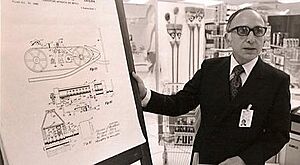Norman Joseph Woodland facts for kids
Quick facts for kids
Norman Joseph Woodland
|
|
|---|---|
 |
|
| Born | September 6, 1921 |
| Died | December 9, 2012 (aged 91) |
| Other names | N. Joseph Woodland N. J. Woodland |
| Alma mater | Drexel University |
| Known for | Co-inventor of the barcode |
Norman Joseph Woodland (born September 6, 1921 – died December 9, 2012) was an American inventor. He is famous for helping to create the barcode. This is the pattern of lines you see on almost every product in stores. He also helped develop the Universal Product Code (UPC) while working at IBM. The UPC is the specific type of barcode used worldwide today.
Contents
Norman Woodland's Early Life
Norman Joseph Woodland was born in Atlantic City, New Jersey, on September 6, 1921. He was the older of two boys in his family.
After finishing Atlantic City High School, Woodland served in the military during World War II. He worked as a technical assistant on a special project in Oak Ridge, Tennessee.
Woodland later earned a degree in Mechanical Engineering from Drexel University in 1947. He also taught mechanical engineering at Drexel from 1948 to 1949.
How the Barcode Was Invented
In 1948, Bernard Silver, a fellow student at Drexel, heard a supermarket manager talking. The manager wanted a way to automatically get product information at the checkout. The university dean said no, but Silver found the idea interesting. He told Woodland about the problem.
Woodland thought they could find a solution. He decided to quit his teaching job and moved to his grandfather's apartment in Florida.
While thinking at the beach, Woodland remembered his Boy Scout training. He recalled how Morse code uses dots and dashes to send messages. He drew dots and dashes in the sand. Then he pulled his fingers through them. This made thin lines from the dots and thick lines from the dashes.
This gave him the idea for a two-dimensional Morse code. He shared his idea with Silver. They used technology similar to that used for sound film. On October 20, 1949, they applied for a patent. They received the patent on October 7, 1952. It covered both the straight-line barcode and a circular "bulls-eye" design.
Developing the Universal Product Code
Woodland started working for IBM in 1951. Even though Woodland and Silver wanted IBM to develop their barcode idea, it wasn't ready for business yet. So, in 1952, they sold their patent for $15,000 to Philco. Philco then sold it to RCA later that same year. RCA tried to create products using the barcode throughout the 1960s. The patent expired in 1969.
In 1969, RCA got the National Association of Food Chains interested in the barcode idea. They formed a committee to create a standard product code. IBM became involved in 1971. When IBM learned about Woodland's earlier work, they moved him to their North Carolina offices.
There, Woodland played a very important role. He helped develop the most widely used version of the barcode. This was the Universal Product Code (UPC). IBM's design won over RCA's in a competition.
The very first item scanned using a UPC barcode was a packet of chewing gum. This happened in an Ohio supermarket in 1974.
Later Life and Passing
Norman Joseph Woodland passed away on December 9, 2012. He was living in Edgewater, New Jersey.
Awards and Recognition
- In 1973, IBM gave Woodland their Outstanding Contribution Award.
- In 1992, President George H. W. Bush awarded him the National Medal of Technology. This was for his important work on barcode technology.
- In 1998, his old university, Drexel University, gave him an honorary degree.
- In 2011, Woodland was added to the National Inventors Hall of Fame.

